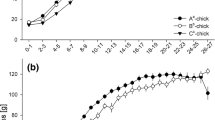Abstract
To investigate the changes in maternal effects during early development in Japanese flounder Paralichthys olivaceus, four-by-four factorial mating by artificial fertilization was performed to produce 16 families. Larvae and juveniles of each family were reared under common environmental conditions until completion of metamorphosis. The magnitude of maternal effects was estimated as the differences between sire and dam variance. maternal effects were highest at hatching was largely affected by egg size, but this effect decreased as larvae grew. Estimated mean heritability during early development was nearly constant (0.14±0.06 for total length and 0.10±0.05 for body depth). Therefore, it is suggested that early development in Japanese flounder is affected by both maternal effect and genetic factors.
Similar content being viewed by others

References
Health DD, Fox CW, Heath JW. Maternal effects on offspring size: variation through early development of Chinook salmon. Evolution 1999; 53: 1605–1611.
Falconer DS. Introduction to Quantitative Genetics (Translated from English by Tanaka Y and Nomura T). Koseisha Koseikaku, Tokyo. 1993; 141–259 (in Japanese).
Mousseau TA, Fox CW. Maternal Effects as Adaptations. Oxford University Press, NY, 1998.
Nakajima N, Taniguchi N. Genetic control of growth in the guppy (Poecilia reticulate). Aquaculture 2002; 204: 393–405.
Nakajima N, Fujio Y. Genetic determination of the growth of the guppy. Nippon Suisan Gakkaishi 1993; 59: 461–464.
Shikano T, Fujio Y. Maternal effect on salinity tolerance in newborn guppy Poecilia reticulate. Fish. Sci. 1998; 64: 52–56.
Yamashita Y. Ecology and releasing technologies. In: Minami T, Tanaka M (eds). Biology and Stock Enhancement of Japanese Flounder. Koseisha Koseikaku, Tokyo. 1997; 107–116 (in Japanese).
Uozumi K, Tabata K. Estimation of the heritability of quantitative traits in fry and juvenile Hirame, Paralichthys olivaceus. Jpn. Aquacult. Soc. 1999; 47: 49–54 (in Japanese).
Shimada Y, Shikano T, Mizuta A, Seikai T. Heritability and maternal effects on body size and survival ability without feeding in newly hatched larvae of Japanese flounder, Paralichthys olivaceus. Jpn. Soc. Fish. Genet. Breed. Sci. 2003; 33: 13–18 (in Japanese).
Fujinami Y, Takeuchi H, Tsuzaki T, Ohta H. Testicular weight and testicular spermatozoa motility of red tilefish, Branchiostegus japonicas, captured in western Wakasa Bay. Nippon Suisan Gakkaishi 2003; 69: 197–2003.
Minami T. The early life history of a flatfish Paralichthys olivaceus. Nippon Suisan Gakkaishi 1982; 48: 1581–1588.
Becker WA. 5th Manual of Quantitative Genetics. Academic Enterprises, Pullman, WA. 1992; 45–102.
Heath DD, Heath JW, Bryden CA, Johnson RM, Fox CW. Rapid evolution of egg size in captive salmon. Science 2003: 299: 1738–1740.
Bagenal TD. Relationship between egg size and fry survival in brown trout Salmo trutta L. J. Fish. Biol. 1969; 1: 349–353.
Becham TD, Murray CB. Effect of female size, egg size and water temperature on developmental biology of chum salmon (Oncorhynchus keta) from the Nitinat River, British Columbia. Can. J. Fish. Aquat. Sci. 1985; 42: 1755–1765.
Rana KJ. Influence of egg size on the growth, onset of feeding, point-of-no-return, and survival of unfed Oreochromis mossambicus fry. Aquaculture 1985; 46: 119–131.
Marteinsdottir G, Able KW. Influence off egg size on embryos and larvae of Fundulus heteroclitus (L.). J. Fish. Biol. 1992; 41: 883–896.
Wallace JC, Aasjord D. An investigation of the consequences of egg size for the culture of Arctic charr, Salvelinus alpinus (L.). J. Fish. Biol. 1984; 24: 427–435.
Kirpichnikov VS. Fish Breeding Genetics (Translated from Russian by Yamagishi H, Takahata M, Nakamura M, and Fukuwatari T). Koseisha Koseikaku, Tokyo. 1983; 53–193 (in Japanese).
Sou S, Seikai T, Tsukamoto K. Cannibalism in lapanese flounder juveniles, Paralichthys olivaceus, reared under controlled conditions. Aquaculture 2000; 182: 149–159.
Author information
Authors and Affiliations
Corresponding author
Rights and permissions
About this article
Cite this article
Shimada, Y., Shikano, T., Murakami, N. et al. Maternal and genetic effects on individual variation during early development in Japanese flounder Paralichthys olivaceus . Fish Sci 73, 244–249 (2007). https://doi.org/10.1111/j.1444-2906.2007.01330.x
Received:
Accepted:
Issue Date:
DOI: https://doi.org/10.1111/j.1444-2906.2007.01330.x



